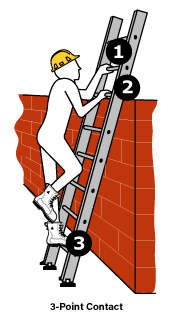Ladders - Climbing Up and Down Safely
On this page
What should you determine before using a ladder?
Back to topDetermine if a ladder is the correct device to use for the situation. Your assessment will include the physical condition of both the ground and the area being reached, the height of the work, the type of work being done, and if other hazards are present.
Determine which type of ladder will be best. Always inspect the ladder before use, and set the ladder up correctly. Read the safety labels and manufacturer instructions as it will provide specific information on the safe use of that particular ladder. This document discusses climbing up and down the ladder. Please see the other documents on Ladders from OSH Answers for more information.
What should you do when climbing up or down a ladder?
Back to topAlways make sure the ladder is tied or secured correctly before using, and is placed on a level, firm and non-slippery surface. When climbing up or down, always:
- Face the stepladder.
- Keep your body centered between side rails.
- Maintain three-point contact by keeping two hands and one foot, or two feet and one hand on a ladder always.
- Keep a firm grip.
- Make sure that footwear is in good condition.
- Clean your footwear by removing mud, water, snow, ice or grease.
- Place feet firmly on each rung.
- Wearing footwear with heels can help to stop the foot from slipping forward.
- You have climbed too high if your knees are above top of the ladder or if you cannot maintain a handhold on the ladder.
- Rise or lower tools and materials using a hoist, hand-line, bucket or other device.
- If using an extension ladder, be careful when stepping or gripping near the locks as the locks will obscure part of the rung.
- In most cases, only allow one person on a ladder at a time. Wait until the other person has stepped off the ladder before another person uses it.
- Have a second person hold the bottom of a long ladder, especially when tying or untying an extension ladder.
- Use the appropriate safety devices when needed (e.g., safety belt, fall restraint, etc.). Check with your jurisdiction for requirements when working at heights near or above 3 metres (10 feet).
- Make sure that any harnesses or ties do not interfere with safe travel when on the ladder.

What should you not do when climbing up or down a ladder?
Back to top- Do not hurry up or slide down a ladder.
- Do not jump from a ladder. Check footing before descending a ladder.
- Do not carry tools or materials in your hand while climbing.
- Do not wear loose clothing, jewellery, or anything else that may catch while climbing.
What are other tips when working on or near ladders?
Back to topOther tips include:
- If working near electricity, do not use an aluminum ladder. Follow your jurisdiction's guidelines on the distances recommended for each level of electrical voltage that may be present.
- Set up warning signs, barricades, lock the door, etc. as necessary to prevent other employees from bumping into the ladder.
- Work from the center of the ladder. If you cannot reach, climb down and move the ladder.
- Do not "shift" or "walk" a stepladder when standing on it.
- Do not use tools that require a lot of leverage (such as a pry or pinch bar) as this motion may cause you to be unbalanced or fall.
- Do not stand, climb, or sit on the stepladder top or pail shelf.
- Do not stand on or above the top two rungs or steps of the ladder.
- Do not allow another person to work below the ladder.
- Do not use a ladder during high winds or other extreme weather.
- Make sure all workers who may climb a ladder are properly trained.
- Fact sheet first published: 2019-01-14
- Fact sheet last revised: 2025-04-15

